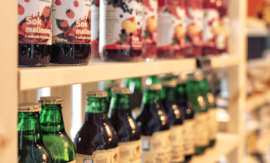Intended learning outcomes: Differentiate between different inventory-control processes for temporal synchronization between use and manufacturing / procurement. Describe the example of pull logistics for order processing with end-product inventory replenishment after consumption.
Section 1.1.6 introduced temporal synchronization between supply and demand as a fundamental problem in logistics. Warehouses serve the storage of goods when manufacturing or procurement is too slow or too early. Figure 4.2.3.1 shows the MEDILS notation for logistics with stocking. Depending on the point of view, or the type of order (see Figure 4.4.4.1), certain cases of inventory control processes result as shown.
Fig. 4.2.3.1 Different inventory control processes for temporal synchronization between use and manufacturing / procurement.
- Manufacturing / procurement takes place only upon actual customer demand. Storage is necessary only if order receipt is too early.
- Manufacturing / procurement is released based on forecast, before there is a definite customer and without need to replace items taken for use. These products are then held in inventory until required by a user. They can then be delivered immediately.
- Demand is filled immediately from inventory. The items taken for use will then be replaced by stock replenishment The replacing items remain in inventory for an indefinite length of time.
Cases 1 and 3 can be considered to be pull logistics. Case 2 is mostly solved by push logistics, as long as there is no definite customer. However, for each case it is clear that carrying inventory only makes sense if goods in stock will be used within a reasonably short period of time. Figure 4.2.3.2 shows the example from the above section once again, this time incorporating inventory control for end products following the Case 3 point of view, that is, “inventory replenishment after consumption.”
Fig. 4.2.3.2 Pull logistics with inventory: order processing with end product inventory.
Note that the sub process “design” is missing here, because this case concerns the selling of already manufactured and stored products.
Course section 4.2: Subsections and their intended learning outcomes

4.2 Push Logistics and Pull Logistics in the Design of Business Processes
Intended learning outcomes: Differentiate between pull logistics and push logistics. Describe the temporal synchronization between use and manufacturing with inventory control processes.

4.2.1 Pull Logistics
Intended learning outcomes: Produce an overview on the subprocesses of a business process in the enterprise, from order acquisition to fulfillment. Describe the interface between subprocesses according to the model “customer-supplier relationship with an internal order”.

4.2.2 Push Logistics
Intended learning outcomes: Describe the interface between subprocesses according to the model “simple sequence”. Explain the interface between subprocesses according to the model “partner relationship with overlapping subprocesses for handing over the order”.

4.2.3 The Temporal Synchronization between Use and Manufacturing with Inventory Control Processes
Intended learning outcomes: Differentiate between different inventory-control processes for temporal synchronization between use and manufacturing / procurement. Describe the example of pull logistics for order processing with end-product inventory replenishment after consumption.
